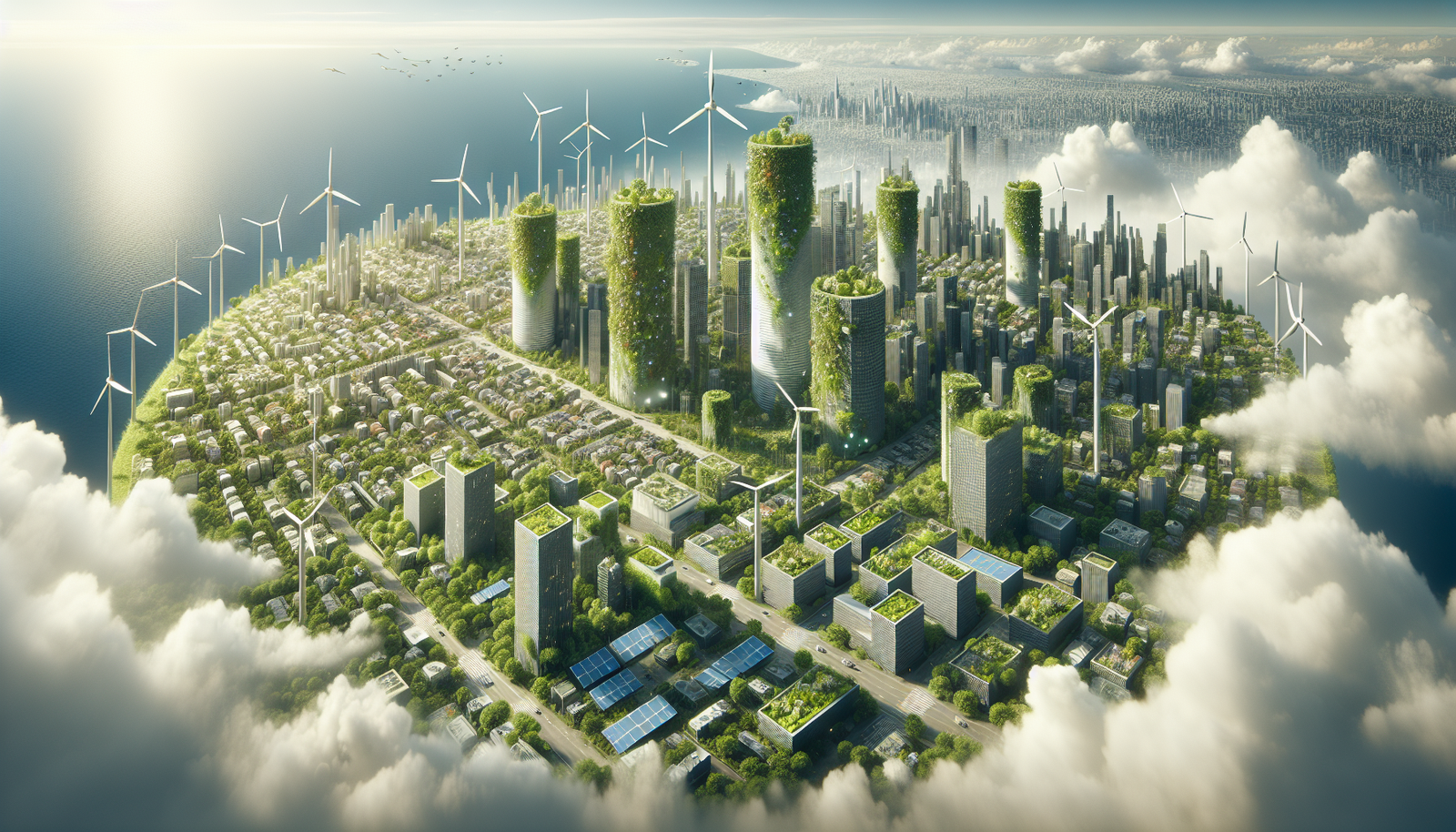Defining Sustainability
Sustainability is a multifaceted concept that has gained significant attention over the past few decades. At its core, sustainability refers to the ability to meet present needs without compromising the ability of future generations to meet their own needs. This definition, popularized by the 1987 Brundtland Report, emphasizes the importance of intergenerational equity and underscores the need for a balanced approach to development.
The term is often broken down into three main pillars: environmental, economic, and social sustainability. These pillars are interconnected and essential for achieving true sustainability. Understanding these components is crucial for developing strategies that promote long-term stability and health of both human societies and natural ecosystems.
- Environmental Sustainability: Focuses on the preservation and careful management of natural resources. It involves practices that reduce environmental degradation and promote the health of ecological systems.
- Economic Sustainability: Involves ensuring that economic activities are conducted in a way that supports long-term economic growth without negatively impacting other aspects of sustainability. It includes practices that promote efficiency and innovation.
- Social Sustainability: Concerned with maintaining and improving social quality, with an emphasis on equity, cultural identity, and community development. It aims to ensure that all individuals have access to basic resources and opportunities.
To better understand these concepts, consider the following table, which outlines key aspects of each sustainability pillar:
| Pillar | Key Aspects |
|---|---|
| Environmental | Resource Management, Pollution Reduction, Ecosystem Health |
| Economic | Growth, Efficiency, Innovation, Employment |
| Social | Equity, Community Development, Education, Health |
By integrating these pillars, sustainability can be seen not just as an environmental concern but as a comprehensive approach to fostering a balanced and resilient world. This holistic understanding is crucial for crafting policies and initiatives that ensure the well-being of both people and the planet.
Historical Context of Sustainability
The concept of sustainability is deeply rooted in human history, although the term itself gained prominence only in the late 20th century. Historically, societies have recognized the importance of balancing environmental stewardship with economic and social growth. For instance, ancient civilizations like the Egyptians and Mesopotamians practiced early forms of sustainable agriculture by rotating crops and conserving water resources, ensuring the longevity of their arable land.
In the modern era, the industrial revolution marked a significant turning point, triggering unprecedented economic growth but also leading to environmental degradation. This period highlighted the need for sustainable practices, yet it wasn’t until the 1970s that the global community began to seriously consider sustainability as a critical issue. The 1972 United Nations Conference on the Human Environment in Stockholm was a pivotal moment, bringing environmental concerns to the forefront of international policy.
The publication of the Brundtland Report in 1987 by the World Commission on Environment and Development further solidified the contemporary understanding of sustainability. The report defined sustainable development as “development that meets the needs of the present without compromising the ability of future generations to meet their own needs.” This definition underscored the interconnectedness of environmental, economic, and social factors, emphasizing a holistic approach to sustainable development.
Below is a timeline highlighting key events in the history of sustainability:
- 1972: UN Conference on the Human Environment in Stockholm.
- 1987: Publication of the Brundtland Report.
- 1992: Earth Summit in Rio de Janeiro, where the Agenda 21 action plan was developed.
- 2015: Adoption of the UN Sustainable Development Goals (SDGs).
Environmental Aspects of Sustainability
The environmental aspects of sustainability focus on the responsible interaction with the planet to maintain natural resources and ecosystems for future generations. This involves understanding and mitigating the adverse impacts of human activities on the environment. Key areas of concern include climate change, biodiversity loss, pollution, and resource depletion. By adopting sustainable practices, individuals and organizations can help reduce their carbon footprint, conserve water, and protect natural habitats.
Climate Change Mitigation is a critical component of environmental sustainability. It involves strategies and actions aimed at reducing greenhouse gas emissions and enhancing carbon sinks. An example of this is the transition to renewable energy sources such as solar, wind, and hydroelectric power. These clean energy sources not only reduce reliance on fossil fuels but also help decrease air pollution. Additionally, sustainable transportation methods, such as cycling and electric vehicles, contribute to lowering emissions.
- Renewable Energy Adoption: Solar, wind, and hydroelectric power.
- Sustainable Transportation: Cycling, electric vehicles, and public transit.
- Energy Efficiency: Improved building insulation and energy-efficient appliances.
Biodiversity Preservation is another crucial element, as it ensures the stability and resilience of ecosystems. Protecting wildlife habitats and endangered species through conservation efforts and protected areas helps maintain ecological balance. Sustainable agricultural practices, such as crop rotation and organic farming, also play a vital role in preserving biodiversity by reducing chemical use and promoting soil health.
- Habitat Conservation: Establishment of protected areas and wildlife corridors.
- Sustainable Agriculture: Organic farming and crop rotation.
- Pollution Reduction: Minimizing the use of chemicals and promoting waste recycling.
The following table provides a comparative overview of traditional vs. sustainable practices:
| Aspect | Traditional Practice | Sustainable Practice |
|---|---|---|
| Energy | Fossil Fuels | Renewable Energy |
| Agriculture | Monoculture | Crop Rotation |
| Transportation | Gasoline Vehicles | Electric Vehicles |
Economic Dimensions of Sustainability
The economic dimensions of sustainability focus on creating systems that support long-term economic growth without negatively impacting social, environmental, and cultural aspects of the community. It involves a shift from traditional economic models to ones that prioritize resource efficiency, social equity, and environmental preservation. This section explores how sustainable economic practices can lead to resilient economies that benefit both current and future generations.
Key Aspects of Sustainable Economics:
- Resource Efficiency: Utilizing resources in a way that maximizes their potential while minimizing waste. This includes adopting circular economy principles, where resources are reused and recycled.
- Green Investments: Investing in technologies and industries that promote renewable energy, reduce carbon footprints, and encourage sustainable production processes.
- Social Equity: Ensuring that economic benefits are distributed fairly across society, reducing inequalities and improving quality of life for all individuals.
The transition towards sustainable economics is also evident in various indicators and metrics. The following table highlights some key metrics used to measure economic sustainability:
| Metric | Description |
|---|---|
| Gross Domestic Product (GDP) Growth | Measures overall economic performance, with an emphasis on sustainable and inclusive growth. |
| Carbon Intensity | Tracks the amount of carbon emissions per unit of GDP, aiming for a reduction over time. |
| Green Job Creation | Monitors the number of jobs in sectors that contribute to environmental sustainability. |
As economies worldwide strive to align with sustainability goals, it is essential to balance economic growth with ecological health and social well-being. By integrating these dimensions, policymakers can pave the way for a future where economic systems are not only prosperous but also sustainable and equitable.
Social Implications of Sustainability
The social implications of sustainability are vast and encompass various aspects of human life and community development. At its core, sustainability aims to ensure that current and future generations can meet their needs without compromising the ability of future generations to meet theirs. This requires a delicate balance between environmental protection, economic growth, and social equity. Social sustainability focuses on maintaining and improving social quality with concepts such as cohesion, reciprocity, and honesty, and it is a crucial pillar in the broader context of sustainable development.
One major social implication of sustainability is the promotion of equitable access to resources. This involves ensuring that all individuals, regardless of their socioeconomic status, have access to basic necessities such as clean water, food, healthcare, and education. Achieving this requires comprehensive policies and initiatives that address disparities and promote inclusivity. Additionally, sustainable practices can lead to job creation and improved working conditions. For instance, the shift towards renewable energy sources often results in new employment opportunities in the green technology sector.
The fostering of strong, resilient communities is another significant social implication of sustainability. Communities that emphasize sustainable practices often enjoy enhanced social cohesion and resilience. This is due to the communal efforts required to implement sustainable solutions, which can strengthen relationships and collective problem-solving capabilities. Moreover, sustainable communities tend to prioritize health and well-being, leading to improved quality of life for their residents. The emphasis on local resources and solutions also supports local economies and reduces dependency on external factors.
To better understand these concepts, consider the following data visualization that highlights key areas of social sustainability:
| Aspect | Description |
|---|---|
| Equity | Ensuring fair access to resources and opportunities for all individuals. |
| Community Resilience | Building strong, adaptable communities that can withstand and recover from adverse situations. |
| Health and Well-being | Promoting healthier lifestyles and environments that contribute to improved overall well-being. |
| Inclusive Growth | Encouraging economic growth that benefits a wide range of community members. |
Sustainability in Agriculture
Sustainability in agriculture is a crucial component of the broader sustainability agenda. It involves the implementation of farming practices that are ecologically viable, economically feasible, and socially equitable. The primary goal is to meet the needs of the present without compromising the ability of future generations to meet their own needs. This concept encompasses various practices and techniques that aim to reduce the environmental impact of farming while boosting productivity and ensuring food security.
One key aspect of sustainable agriculture is the reduction of resource consumption. Traditional farming methods often rely heavily on water, fertilizers, and pesticides, which can lead to resource depletion and environmental degradation. Sustainable practices, on the other hand, focus on efficient resource use. For instance, crop rotation is employed to enhance soil health and reduce dependency on chemical inputs. Additionally, integrated pest management (IPM) minimizes the use of harmful pesticides by employing natural predators and biopesticides.
To illustrate the implementation of sustainable practices, consider the following data on resource consumption in agriculture:
| Resource | Traditional Methods | Sustainable Practices |
|---|---|---|
| Water Usage (liters/kg of crop) | 2000 | 1200 |
| Fertilizer Application (kg/ha) | 150 | 80 |
| Pesticide Use (liters/ha) | 20 | 5 |
Furthermore, sustainable agriculture also emphasizes social aspects, such as supporting local communities and ensuring fair labor practices. By fostering local food systems and encouraging farm-to-table initiatives, sustainable agriculture seeks to provide economic benefits to local farmers and communities. These initiatives often include organic farming and community-supported agriculture (CSA) programs, which help reduce the carbon footprint associated with food transportation and promote local biodiversity.
- Enhancing soil health through organic matter addition
- Promoting biodiversity with polyculture systems
- Utilizing renewable energy sources for farming operations
- Adopting precision agriculture techniques to minimize waste
Sustainability in Urban Development
Sustainability in urban development is a critical aspect of modern city planning, aimed at creating environments that support both current and future generations. This involves integrating sustainable practices into the design, construction, and operation of urban areas. One of the primary goals is to reduce the environmental impact of cities, which are responsible for a significant portion of global carbon emissions. To achieve this, strategies such as green building, energy efficiency, and the use of renewable resources are employed.
Urban areas are increasingly adopting smart city technologies to enhance sustainability. These technologies include the use of sensors and data analytics to optimize resource use and improve the quality of urban life. For instance, smart grids help manage electricity consumption more efficiently, while intelligent transportation systems aim to reduce traffic congestion and emissions. Below is a basic outline of some key sustainable practices in urban development:
- Green Spaces: Incorporating parks and green roofs to reduce urban heat and improve air quality.
- Public Transportation: Expanding and enhancing public transport options to decrease reliance on personal vehicles.
- Water Management: Implementing systems for rainwater harvesting and wastewater recycling.
The impact of these practices can be seen in various urban development projects worldwide. For example, cities like Copenhagen and Singapore have been recognized for their innovative approaches to sustainability. In these cities, the integration of green spaces and efficient public transportation systems has significantly improved the urban environment. The table below illustrates some key metrics comparing sustainable urban development initiatives in different cities:
| City | Green Space Percentage | Public Transport Usage | Renewable Energy Usage |
|---|---|---|---|
| Copenhagen | 32% | 45% | 40% |
| Singapore | 47% | 55% | 20% |
Technological Innovations for Sustainability
Technological innovations play a critical role in advancing sustainability by providing novel solutions to environmental, social, and economic challenges. These advancements are reshaping industries and creating new opportunities for sustainable development. Renewable energy technologies, such as solar panels and wind turbines, are prime examples of how technology can reduce reliance on fossil fuels and lower greenhouse gas emissions. By harnessing the power of nature, these technologies contribute to a cleaner and more sustainable future.
Another area where technology is making a significant impact is in resource management. Smart technologies, such as the Internet of Things (IoT), are being utilized to optimize the use of resources like water and energy in real-time. For instance, smart grids allow for more efficient distribution of electricity, reducing waste and maximizing the use of renewable sources. Similarly, precision agriculture technologies enable farmers to monitor crop health and soil conditions, leading to more sustainable farming practices.
Technological innovations are also enhancing waste management and recycling processes. Advanced sorting technologies and the development of biodegradable materials are helping to reduce landfill waste and promote the circular economy. For instance, autonomous sorting robots are now capable of separating recyclable materials with high accuracy, improving the efficiency of recycling facilities.
Below is a table showcasing some key technological innovations and their contributions to sustainability:
| Technology | Application | Impact on Sustainability |
|---|---|---|
| Solar Panels | Renewable Energy | Reduces carbon footprint and reliance on fossil fuels |
| Smart Grids | Energy Distribution | Enhances energy efficiency and integrates renewable sources |
| Precision Agriculture | Farming | Optimizes resource use and improves crop yield |
| Autonomous Sorting Robots | Recycling | Increases recycling efficiency and reduces waste |
Policy and Governance in Sustainability
Policy and governance play a pivotal role in the advancement of sustainability practices across the globe. Governments, international bodies, and local authorities are increasingly recognizing the importance of integrating sustainable principles into policy frameworks. Effective governance structures ensure that sustainability goals are not only set but are also achieved through a combination of regulations, incentives, and collaborative efforts. Policies that promote renewable energy, reduce carbon emissions, and encourage sustainable agriculture are becoming more prevalent as nations strive to balance economic growth with environmental preservation.
One of the critical aspects of sustainability governance is the implementation of international agreements and treaties. Agreements such as the Paris Agreement on climate change have set the stage for global cooperation by establishing binding commitments for countries to reduce greenhouse gas emissions. Moreover, these agreements often encourage the development of national policies that align with international objectives. Such alignment is crucial to ensure that sustainability efforts are not undermined by conflicting local and global agendas.
Governance in sustainability also involves a multi-stakeholder approach that includes businesses, non-governmental organizations, and civil society. By fostering partnerships among these groups, policies can be more comprehensive and effective. For instance, public-private partnerships can drive innovation and investment in sustainable technologies. Furthermore, involving local communities in decision-making processes ensures that policies are culturally sensitive and locally relevant.
To illustrate the impact of policy and governance, consider the following data on renewable energy adoption:
| Country | Renewable Energy (% of Total Energy) | Policy Initiatives |
|---|---|---|
| Germany | 42% |
|
| China | 26% |
|
| United States | 20% |
|
These examples underscore the significance of tailored policy measures in enhancing renewable energy usage, thus contributing to sustainability objectives. Effective governance ensures that such policies are continuously monitored and adapted to meet evolving challenges and opportunities in the realm of sustainability.
Sustainability in Business Practices
Sustainability in business practices has become a crucial component for companies aiming to thrive in the modern world. Businesses are increasingly recognizing the importance of integrating sustainable practices into their operations, not only to minimize environmental impact but also to enhance their brand reputation and drive economic value. By adopting sustainable methods, companies can reduce waste, improve resource efficiency, and create long-term value for stakeholders. This shift is driven by consumer demand for environmentally responsible products and a growing awareness of the finite nature of resources.
Several prominent companies have set benchmarks in sustainable business practices. For instance, many organizations have committed to reducing their carbon footprint, implementing energy-efficient technologies, and using renewable energy sources. These efforts are often encapsulated in Corporate Social Responsibility (CSR) programs, which outline a company’s commitment to sustainable development. Below is a table illustrating some key sustainable practices adopted by leading companies:
| Company | Sustainable Practice | Impact |
|---|---|---|
| Company A | Use of 100% renewable energy | Reduction in carbon emissions by 40% |
| Company B | Implementation of closed-loop recycling | Reduction in waste by 60% |
| Company C | Sustainable sourcing of raw materials | Improvement in local biodiversity |
The adoption of sustainability in business is not limited to environmental benefits. It also encompasses social and economic dimensions. Companies are now focusing on ethical labor practices, fair trade, and community engagement, which contribute to social sustainability. Furthermore, economic sustainability is pursued by fostering innovation, ensuring the longevity of business operations, and maintaining robust economic health. The following list outlines the primary benefits of integrating sustainability in business:
- Enhanced brand reputation and customer loyalty
- Increased operational efficiency and cost savings
- Improved compliance with regulatory requirements
- Attraction and retention of top talent
- Long-term financial performance and resilience
The Role of Education in Promoting Sustainability
Education plays a pivotal role in promoting sustainability by equipping individuals with the knowledge, skills, and values necessary to foster sustainable practices. At its core, education for sustainability aims to empower learners with the ability to make informed decisions that consider the long-term impact on the environment, economy, and society. Incorporating sustainability into the educational curriculum ensures that students are not only aware of environmental challenges but also understand the interconnections between human and ecological systems.
Various educational strategies can be applied to integrate sustainability concepts into learning environments. These include interdisciplinary approaches that combine science, economics, and social studies to provide a holistic understanding of sustainability issues. Additionally, experiential learning methods such as project-based learning and outdoor education encourage students to engage directly with their environment, fostering a deeper appreciation and sense of responsibility. The importance of education in promoting sustainability is further underscored by the United Nations’ Sustainable Development Goal 4, which emphasizes the need for inclusive and equitable quality education.
Data from a recent study highlights the effectiveness of sustainability education. The study found that schools incorporating comprehensive sustainability curricula showed a significant increase in student awareness and engagement with sustainability practices. The table below demonstrates the impact of sustainability education on student behavior:
| Behavioral Change | Before Education (%) | After Education (%) |
|---|---|---|
| Recycling Participation | 45 | 78 |
| Energy Conservation | 30 | 65 |
| Community Involvement | 20 | 50 |
Moreover, educators and institutions are encouraged to adopt sustainable practices themselves, serving as role models for students. Creating a sustainable school environment, such as implementing waste reduction programs and energy-efficient technologies, can reinforce classroom learning and demonstrate practical applications of sustainability principles. By embedding these practices in their operations, educational institutions can contribute significantly to a more sustainable future, inspiring students to carry forward the values of sustainability into their personal and professional lives.
Challenges to Achieving Sustainability
Achieving sustainability is fraught with numerous challenges that span environmental, economic, and social dimensions. One of the most significant obstacles is the over-reliance on fossil fuels which contributes to climate change and environmental degradation. Transitioning to renewable energy sources is essential but requires substantial investment and infrastructure changes. Many developing nations face the dilemma of balancing economic growth with sustainable practices, often prioritizing immediate economic benefits over long-term environmental health.
Another challenge is the inequitable distribution of resources. Wealth disparities lead to unequal access to sustainable technologies and practices, hindering global efforts to achieve sustainability. Developed countries often have the financial means to invest in sustainable infrastructure, while developing nations struggle with basic needs. This disparity is further illustrated in the table below:
| Country Category | Access to Clean Energy (%) | Investment in Sustainability (Billion USD) |
|---|---|---|
| Developed Countries | 80 | 500 |
| Developing Countries | 30 | 50 |
Moreover, there are significant social challenges related to changing public perceptions and behaviors. Achieving sustainability requires a collective shift in mindset, where individuals prioritize long-term environmental benefits over short-term conveniences. Education and awareness campaigns are crucial but often face resistance due to ingrained habits and cultural norms. Additionally, political challenges arise when policymakers face pressure from industries that may be adversely affected by sustainable regulations. Crafting policies that balance economic interests with environmental stewardship remains a complex task.
In summary, while the path to sustainability is clear, the journey is hindered by various challenges. Addressing these requires a collaborative effort from governments, businesses, and individuals alike. A comprehensive strategy that includes technological innovation, equitable resource distribution, and policy reforms is essential to overcome these barriers and pave the way for a sustainable future.
Future Prospects for Sustainability
The future prospects for sustainability are both promising and challenging. As global awareness of environmental issues continues to grow, more individuals, businesses, and governments are committing to sustainable practices. Technological advancements play a crucial role in this transition, offering innovative solutions to reduce carbon footprints and enhance resource efficiency. Renewable energy sources such as solar, wind, and hydroelectric power are becoming more accessible and affordable, paving the way for a significant reduction in reliance on fossil fuels.
However, achieving sustainability requires coordinated efforts across various sectors. The economic aspect of sustainability emphasizes the need for sustainable business practices that not only focus on profit but also consider environmental and social impacts. Companies are increasingly adopting corporate social responsibility (CSR) initiatives, integrating sustainability into their core strategies. This shift is evident in the growing trend of green investment, where investors prioritize funding environmentally responsible projects.
On the social front, education and awareness are key drivers of change. By embedding sustainability into educational curricula, future generations are better equipped to make informed decisions that benefit the planet. Additionally, community-led sustainability projects empower individuals to take action at the local level. These initiatives often include urban gardening, recycling programs, and energy conservation efforts. The collective impact of these actions is significant, fostering a culture of sustainability that extends beyond individual communities.
Looking ahead, the integration of sustainability metrics into policy and decision-making processes is vital. Governments and organizations are increasingly using data-driven approaches to measure and track progress toward sustainability goals. This often involves the use of comprehensive indicators such as the Environmental Performance Index (EPI) or the Sustainable Development Goals (SDGs). By leveraging data, stakeholders can identify areas for improvement and develop targeted strategies to achieve a sustainable future.



